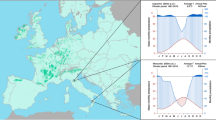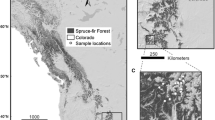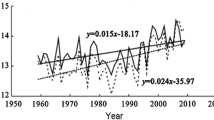Abstract
Northern hemisphere tree species growing at their northern range margins may be particularly responsive to climate change and could provide important information regarding future broad-scale responses. We analyzed and compared tree-ring data between five Douglas-fir [Pseudotsuga menziesii var. glauca (Mirb.) Franco] populations growing at the species’ northernmost distribution in British Columbia, Canada, and five populations located 150 km to the southeast. We quantified climate–growth relationships using uni- and multivariate techniques at different temporal scales. Our data suggest that (1) even at its northernmost distributions, precipitation limits long-term mature Douglas-fir radial growth more than temperatures, (2) northernmost Douglas-fir populations are distinct from populations located further within the species’ range in terms of certain key short-term growth responses, and (3) northernmost Douglas-fir growth sensitivities to climate may be increasing over time. In the future, mature Douglas-fir productivity in the northern portion of its range may be primarily limited by precipitation, and responses may be strongest at the species’ range margins.








Similar content being viewed by others
References
Aitken SN, Yeaman S, Holliday JA, Wang T, Curtis-McLane S (2008) Adaptation, migration or extirpation: climate change outcomes for tree populations. Evol Appl 1:95–111
BC MoE (2007) Environmental trends in British Columbia: 2007. State of Environment Reporting BC Ministry of Environment. Available from http://www.env.gov.bc.ca/soe/et07/. Accessed 5 February 2007
Biondi F (2000) Are climate–tree growth relationships changing in north-central Idaho, U.S.A.? Arct Antarct Alp Res 32:111–116
Biondi F, Waikul K (2004) Dendroclim2002: a C++ program for statistical calibration of climate signals in tree-ring chronologies. Comput Geosci 30:303–311
Büntgen U, Frank DC, Schmidhalter M, Burkhard N, Seifert M, Esper J (2006) Growth/climate response shift in a long subalpine spruce chronology. Trees 20:99–110
Carrer M, Urbinati C (2006) Long-term change in the sensitivity of tree-ring growth to climate forcing in Larix decidua. New Phytol 170:861–872
Case MJ, Peterson DL (2005) Fine-scale variability in growth-climate relationships of Douglas-fir, North Cascade Range, Washington. Can J For Res 35:2743–2755
Cayan DR, Kammerdiener SA, Dettinger MD, Caprio JM, Peterson DH (2001) Changes in the onset of spring in the western United States. Bull Am Meteorol Soc 82:399–415
Christensen JH, Hewitson B, Busuioc A, Chen A, Gao X, Held I, Jones R, Kolli RK, Kwon WT, Laprise R, Magaña Rueda V, Mearns L, Menéndez CG, Räisänen J, Rinke A, Sarr A, Whetton P (2007) Regional climate projections. In: Solomon SD, Qin D, Manning M et al (eds) The physical science basis. Contribution of working group I to the Fourth Assessment Report of the Intergovernmental Panel on Climate Change. Cambridge University Press, New York, pp 848–940
Cook E (1985) A time series analysis approach to tree-ring standardization. Dissertation, University of Arizona
Cook E, Kairiukstis L (1990) Methods of dendrochronology: applications in the environmental sciences. Kluwer, Dordrecht
Cook ER, Krusic P (2005) Users manual for program ARSTAN Tree-Ring Lab, Lamont-Doherty Earth Observatory, Columbia University. Available from http://www.ldeo.columbia.edu/res/fac/trl/public/publicSoftware.html. Accessed 14 Oct 2006
D’Arrigo R, Wilson R, Liepert B, Cherubini P (2007) On the ‘Divergence problem’ in Northern Forests: a review of the tree-ring evidence and possible causes. Glob Planet Change 289–305
Daintith N, Vyse A (1999) Douglas-fir in the British Columbia interior: research and management experience. In: Lousier JD, Kessler WB (eds) Ecology and management of interior Douglas-fir (Pseudotsuga menziesii var glauca) at the northern extreme of its range. Proceedings of a workshop held 7–9 October 1996 in Fort St. James, British Columbia. University of Northern British Columbia, Prince George, BC, pp 24–26
Daniels LD, Veblen TT (2004) Spatiotemporal influences of climate on altitudinal treeline in northern Patagonia. Ecology 85:1284–1296
DeLong SC (1999) Ecology of Douglas-fir at its northern limits. In: Lousier JD, Kessler WB (eds) Ecology and management of interior Douglas-fir (Pseudotsuga menziesii var glauca) at the northern extreme of its range. Proceedings of a workshop held 7–9 October 1996 in Fort St. James, British Columbia. University of Northern British Columbia, Prince George, BC, pp 27–28
Feliksek E, Wilczynski S (2003) Dendroecological characterization of Douglas-fir (Pseudotsuga menziesii Franco) in the Wielkopolska region. Elect J Polish Agric Univ Ser For 6:1
Fritts HC (1976) Tree rings and climate. The Blackburn Press, New Jersey
Givnish TJ (1995) Plant stems: biomechanical adaptation for energy capture and influence on species distributions. In: Barbara GL (ed) Plant stems: physiology and functional morphology. Academic Press, San Diego, pp 3–49
Gray ST, Betancourt JL, Jackson ST, Eddy RG (2006) Role of multidecadal climate variability in a range extension of pinyon pine. Ecology 87:1124–1130
Green DS (2005) Adaptive strategies in seedlings of three co-occurring, ecologically distinct northern coniferous tree species across and elevational gradient. Can J For Res 35:910–917
Griesbauer H, Green DS (2010) Regional and ecological patterns in interior Douglas-fir climate–growth relationships in British Columbia, Canada. Can J For Res (in press)
Guiot J (1990) Methods of calibration. In: Cook ER, Kairiukstis LA (eds) Methods of dendrochronology. Kluwer, Dordrecht, pp 165–177
Hamann A, Wang T (2006) Potential effects of climate change on ecosystem and tree species distribution in British Columbia. Ecology 87:2773–2786
Hermann RK, Lavender DP (1990) Douglas-fir U.S. Department of Agriculture. Available from http://www.na.fs.fed.us/spfo/pubs/silvics_manual/Volume_1/pseudotsuga/menziesii.htm. Accessed July 15, 2006
Holmes R (1983) Computer-assisted quality control in tree-ring dating and measuring. Tree-Ring Bull 43:69–78
Huang J, Tardif JC, Bergeron Y, Denneler B, Berninger F, Girardin MP (2009) Radial growth response of four dominant boreal tree species to climate along a latitudinal gradient in the eastern Canadian boreal forest. Global Change Biol. doi:10.1111/j.1365-2486.2009.01990.x
Josza L (1988) Increment core sampling techniques for high quality cores Rep. Special Publication SP-30. Forintek Canada Corp, Vancouver, BC
Jull MJ (1999) Douglas-fir silviculture “on the edge”: silvicultural systems at the northern range of the species. In: Lousier JD, Kessler WB (eds) Ecology and management of interior Douglas-fir (Pseudotsuga menziesii var. glauca) at the northern extreme of its range. Proceedings of a workshop held 7–9 October 1996 in Fort St. James, British Columbia. Prince George, BC. University of Northern British Columbia, Prince George, BC, pp 34–44
Kessler WB (1999) Workshop summary: research themes emerging from the Douglas-fir problem analysis. In: Lousier JD, Kessler WB (eds) Ecology and management of interior Douglas-fir (Pseudotsuga menziesii var glauca) at the northern extreme of its range. Proceedings of a workshop held 7–9 October 1996 in Fort St. James, British Columbia. University of Northern British Columbia, Prince George, BC, pp 92
Kozlowski TT, Pallardy SG (1997) Growth control in woody plants. Academic Press, San Diego
Littell JS (2006) Climate impacts to forest ecosystem processes: Douglas-fir growth in north-western U.S. mountain landscapes and area burned by wildfire in western U.S. eco-provinces. Dissertation, University of Washington
Littell JS, Peterson DL (2005) A method for estimating vulnerability of Douglas-fir growth to climate change in the northwestern U.S. Forest Chron 81:369–374
Littell JS, Peterson DL, Tjoelker M (2008) Douglas-fir growth in mountain ecosystems: water limits tree growth from stand to region. Ecol Monogr 78:349–368
Loehle C (1998) Height growth rate tradeoffs determine northern and southern range limits for trees. J Biogeogr 735–742
Loehle C (2000) Forest ecotone response to climate change: sensitivity to temperature response functional forms. Can J For Res 30:1632–1645
Mantua NJ, Hare SR (2002) The Pacific decadal oscillation. J Oceanogr 58:35–44
Mantua NJ, Hare SR, Zhang Y, Wallace JM, Francis RC (1997) A Pacific interdecadal climate oscillation with impacts on salmon production. Bull Am Meteorol Soc 78:1069–1079
Mekis É, Hogg WD (1999) Rehabilitation and analysis of Canadian daily precipitation time series. Atmos Ocean 37:53–85
Minobe S (2000) Spatio-temporal structure of the pentadecadal variability over the North Pacific. Prog Oceanogr 47:381–408
O’Neill GA, Hamann A, Wang T (2008) Accounting for population variation improves estimates of the impact of climate change on species’ growth and distribution. J Appl Ecol 45:1040–1049
Parmesan C (2006) Ecological and evolutionary responses to recent climate change. Annu Rev Ecol Evol Syst 37:637–669
Pederson N, Cook ER, Jacoby GC, Peteet DM, Griffin KL (2004) The influence of winter temperatures on the annual radial growth of six northern range margin tree species. Dendrochronologia 22:7–29
Pike RG, Spittlehouse DL, Bennett KE, Egginton VN, Tschaplinski PJ, Murdock TQ, Werner AT (2008) Climate change and watershed hydrology: part i–recent and projected changes in British Columbia. Streamline Watershed Manage Bull 11:1–6
Régent Instruments Inc (2005) WinDENDROTM. An image analysis system for tree-rings analysis Régent Instruments Inc, Quebec, QC
Rehfeldt J (1991) The genetic resource of Douglas-fir in the interior northwest. In: Baumgartner DM (ed) Interior Douglas-fir: the species and its management symposium proceedings. Department of Natural Resource Sciences, Washington State University, Pullman, Washington, pp 53–62
Rogers BJ (2006) An investigation of Douglas-fir leave-tree mortality in the sub-boreal spruce zone: a temporal and spatial assessment of water relations under pre and post harvest conditions. M.Sc. thesis, University of Northern British Columbia
Stahl K, Moore RD, McKendry IG (2006) The role of synoptic-scale circulation in the linkage between large-scale ocean-atmosphere indices and winter surface climate in British Columbia, Canada. Int J Climatol 26:541–560
St. Clair JB, Mandel NL, Vance-Borland K (2005) Genecology of douglas fir in Western Oregon and Washington. Ann Bot 96:1199–1214
Sutton A, Staniforth RJ, Tardif J (2002) Reproductive ecology and allometry of red pine (Pinus resinosa) at the northwestern limit of its distribution range in Manitoba. Canada 80:482–493
Tabachnick BG, Fidell LS (2001) Using multivariate statistics, 4th edn. Allyn and Bacon, Boston
Tardif JC, Conciatori F, Nantel P, Gagnon D (2006) Radial growth and climate responses of white oak (Quercus alba) and northern red oak (Quercus rubra) at the northern distribution limit of white oak in Quebec, Canada. J Biogeogr 33:1657–1669
The Mathworks Inc (2007) Matlab 2007 The Mathworks Inc. Available from http://www.mathworks.com. Accessed January 5, 2008
Vaganov EA, Hughes MK, Kirdyanov AV, Schweingruber FH, Silkin PP (1999) Influence of snowfall and melt timing on tree growth in subarctic Eurasia. Nature 400:149–151
Vincent LA, Gullett DW (1999) Canadian historical and homogenous temperature datasets for climate change analyses. Int J Climatol 19:1375–1388
Vincent LA, Zhang X, Bonsal BR, Hogg WD (2002) Homogenization of daily temperatures over Canada. J Clim 15:1322–1334
Walther GR (2003) Plants in a warmer world. Persp Plant Ecol Evol Syst 6:169–185
Walther GR, Post E, Convey P, Menzei A, Parmesan C, Beebee TJC, Fromentin JM, Hoegh-Guldberg O, Bairlein F (2002) Ecological responses to recent climate change. Nature 416:389–395
Watson E, Luckman BH (2002) The dendroclimatic signal in Douglas-fir and ponderosa pine tree-ring chronologies from the southern Canadian Cordillera. Can J For Res 32:1858–1874
Watson E, Luckman B (2004) Tree-ring based reconstructions of precipitation for the Southern Canadian Cordillera. Clim Change 65:209–241
Wigley TML, Jones PD, Briffa KR (1984) On the average value of correlated time series, with applications in dendroclimatology and hydrometeorology. J Clim Appl Meteorol 23:201–213
Wilmking M, Juday GP, Barber VA, Zald HSJ (2004) Recent climate warming forces contrasting growth responses of white spruce at treeline in Alaska through temperature thresholds. Global Change Biol 10:1724–1736
Wilson R, Elling W (2004) Temporal instability in tree growth/climate response in the Lower Bavarian Forest region: implications for dendroclimatic reconstruction. Trees 18:19–28
Wilson RJS, Luckman BH (2002) Tree-ring reconstruction of maximum and minimum temperatures and the diurnal temperature range in British Columbia, Canada. Dendrochronologia 20:257–268
Zhang QB, Hebda RJ (2004) Variation in radial growth patterns of Pseudotsuga menziesii on the central coast of British Columbia, Canada. Can J For Res 34:1946–1954
Acknowledgments
We thank Kasia Caputa, Yumiko Miyamoto, Emily Müller, and Kara Przeczek for their assistance in the field and laboratory. We also thank Dr. Stephen Déry and Dr. Greg O’Neill for advice and constructive comments through all components of this study, and Bruce Rogers and Gretchen Prystawik for review of this manuscript. This work was funded through the Natural Sciences and Engineering Research Council of Canada, the British Columbia Forest Science Program, and the Province of British Columbia.
Author information
Authors and Affiliations
Corresponding author
Additional information
Communicated by R. Guy.
Rights and permissions
About this article
Cite this article
Griesbauer, H.P., Scott Green, D. Assessing the climatic sensitivity of Douglas-fir at its northern range margins in British Columbia, Canada. Trees 24, 375–389 (2010). https://doi.org/10.1007/s00468-009-0407-z
Received:
Revised:
Accepted:
Published:
Issue Date:
DOI: https://doi.org/10.1007/s00468-009-0407-z




